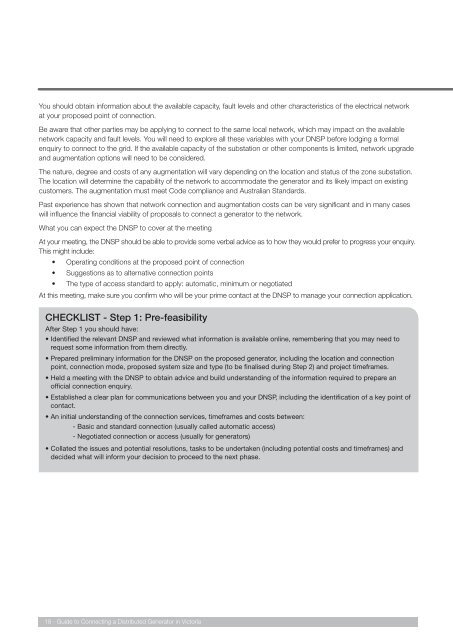Guide to Connecting a Distributed Generator - Sustainability Victoria
Guide to Connecting a Distributed Generator - Sustainability Victoria
Guide to Connecting a Distributed Generator - Sustainability Victoria
Create successful ePaper yourself
Turn your PDF publications into a flip-book with our unique Google optimized e-Paper software.
You should obtain information about the available capacity, fault levels and other characteristics of the electrical networkat your proposed point of connection.Be aware that other parties may be applying <strong>to</strong> connect <strong>to</strong> the same local network, which may impact on the availablenetwork capacity and fault levels. You will need <strong>to</strong> explore all these variables with your DNSP before lodging a formalenquiry <strong>to</strong> connect <strong>to</strong> the grid. If the available capacity of the substation or other components is limited, network upgradeand augmentation options will need <strong>to</strong> be considered.The nature, degree and costs of any augmentation will vary depending on the location and status of the zone substation.The location will determine the capability of the network <strong>to</strong> accommodate the genera<strong>to</strong>r and its likely impact on existingcus<strong>to</strong>mers. The augmentation must meet Code compliance and Australian Standards.Past experience has shown that network connection and augmentation costs can be very significant and in many caseswill influence the financial viability of proposals <strong>to</strong> connect a genera<strong>to</strong>r <strong>to</strong> the network.What you can expect the DNSP <strong>to</strong> cover at the meetingAt your meeting, the DNSP should be able <strong>to</strong> provide some verbal advice as <strong>to</strong> how they would prefer <strong>to</strong> progress your enquiry.This might include:• Operating conditions at the proposed point of connection• Suggestions as <strong>to</strong> alternative connection points• The type of access standard <strong>to</strong> apply: au<strong>to</strong>matic, minimum or negotiatedAt this meeting, make sure you confirm who will be your prime contact at the DNSP <strong>to</strong> manage your connection application.CHECKLIST - Step 1: Pre-feasibilityAfter Step 1 you should have:•Identified the relevant DNSP and reviewed what information is available online, remembering that you may need <strong>to</strong>request some information from them directly.• Prepared preliminary information for the DNSP on the proposed genera<strong>to</strong>r, including the location and connectionpoint, connection mode, proposed system size and type (<strong>to</strong> be finalised during Step 2) and project timeframes.• Held a meeting with the DNSP <strong>to</strong> obtain advice and build understanding of the information required <strong>to</strong> prepare anofficial connection enquiry.• Established a clear plan for communications between you and your DNSP, including the identification of a key point ofcontact.• An initial understanding of the connection services, timeframes and costs between:- Basic and standard connection (usually called au<strong>to</strong>matic access)- Negotiated connection or access (usually for genera<strong>to</strong>rs)• Collated the issues and potential resolutions, tasks <strong>to</strong> be undertaken (including potential costs and timeframes) anddecided what will inform your decision <strong>to</strong> proceed <strong>to</strong> the next phase.18 - <strong>Guide</strong> <strong>to</strong> <strong>Connecting</strong> a <strong>Distributed</strong> Genera<strong>to</strong>r in Vic<strong>to</strong>ria




